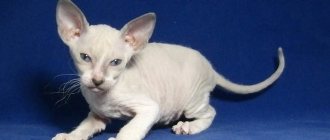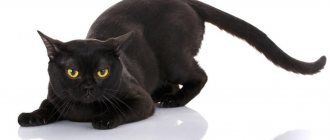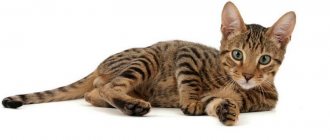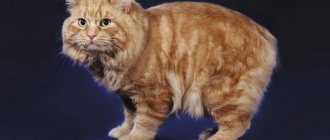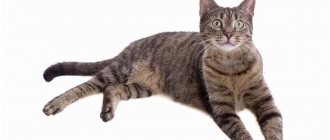There are several legends associated with the Thai cat breed. This is the rare case when an animal with a slanted eye or a squiggle on its tail has value. Since it is precisely such individuals that are considered the real heirs of the very cat that, according to legend, was assigned to guard the jewelry of the Thai princess. While the royal lady was bathing in the river, the pussy strung jewelry on her tail and swam after her mistress. At the same time, the animal had to keep an eye on the treasure. Since then, a tail with a bend and an eye with a pigtail are a sign of the purebred of the breed. You may not be the heirs of the crown, but a gentle purring creature will enter your life just as faithfully, responsibly and in a masterful manner.
Origin of the breed
These cats are named after their ancient homeland - Thailand.
The oldest images of Thai cats date back to the 14th century. The breed is considered the grandmother of modern Siamese cats and was previously even called the old type. The difference in breeds appeared due to the achievements of selection. Old-type Siamese cats came to Europe at the end of the 19th century, and to America at the beginning of the 20th. Breeders were so carried away by breeding the graceful and sharp-angled Siamese cat that they almost forgot about the original apple-headed appearance of this breed.
It was the lovers of the old type of Siamese cats who saved the situation - the work of enthusiasts returned these round-faced cats to the world. The Thai cat standard was registered 30 years later than the Siamese - in 1990.
Mr. Cat recommends: colors
The main component of the color of a Thai cat is contrast. The lighter the hair on the body, the darker it should be on the face, paws and tail. These markings, which differ in contrast, are called points in the language of felinologists.
Kittens are born almost white, characteristic signs appear after three months. The wool is soft and delicate.
The breed standards approve 6 colors:
- seal-point – dark brown or black marks with white or cream color of the main coat;
- red-point – red spots, with a white color of the main shade;
- torty-point – tortoiseshell pattern;
- chocolate-point – chocolate or “coffee with milk” with the main color being ivory;
- blue-point – blue or gray markings, the color of the main coat is a bluish-cold shade;
- tabby-point - a new color of a mixed type, when the stripes are of different colors;
- lilac-point – very rare color: lilac points, main coat color – magnolia.
- cream-point – white background with cream points.
Thanks to the contrasting combination, the appearance of Thai cats is elegant and expressive. Experts note that at a young age, all colors have a lighter texture, and adult animals darken.
Advantages and disadvantages
All representatives of the cat world have advantages and disadvantages. The Thai cat is no exception.
Positive features:
- affectionate, sociable;
- smart;
- do not require special care;
- strong immunity;
- live long.
Negative points (based on reviews):
- do not tolerate loneliness well;
- for some owners - talkativeness, especially during estrus;
- complex nature;
- can be vindictive and harmful.
External features of Siamese cats
Modern Siamese cats have a fairly characteristic appearance, the most noticeable details of which are almond-shaped blue eyes, large, vertically set ears, the tips of which conventionally form a regular triangle with the nose. The Siamese is also characterized by a long, thin tail and a fairly powerful but graceful body, covered with short, close-fitting silky hair without undercoat. The animals weigh on average from 3 to 8 kg, and their height at the withers reaches 30 cm.
Coloring is another characteristic feature of Siamese cats. Although experts distinguish many types of Siamese color, the original “mask” on the face, the color of the ears, tail and limbs remain unchanged - they are always dark compared to other parts of the body. This is caused by the difference in skin temperature - at the extreme points its value is usually lower, as a result of which the wool in these places has a higher content of dark pigment.
Siamese kittens are completely white at birth, and the characteristic darkening of their fur appears after some time. They acquire their final color only at the same time as puberty. This is a manifestation of acromelanism, incomplete albinism, which is associated with temperature conditions. Dark areas are called points, and specific colors of Siamese are called color points, of which there are quite a lot of variations: seal, blue, liliak, tabby, chocolate, etc.
Specific colors of the Siamese cat (photo gallery)
There are also related breeds with a characteristic color, blue eyes, but different body proportions, coat characteristics, muzzle outlines and other “cosmetic” differences (Balinese, Oriental, Peterbald, Tonkinese, Thai, etc.). Common features of representatives of the Siamese-Oriental group:
- flexible, graceful body;
- almond-shaped eyes;
- whip-shaped tail;
- large ears;
- wedge-shaped muzzle;
- good health;
- friendliness and talkativeness.
Appearance
The standard approved in 1991 is currently under revision, so the breed is considered open. This means that any animal similar in phenotype to a Thai cat can be classified as a representative. To confirm such affiliation, it is necessary to have two expert signatures in the registration documents. Such animals are allowed for official breeding.
Head
Round, without pronounced angularities and flat fragments. The forehead is moderately convex, the transition to the nose is clearly marked and is level with the eyes, in no case below the conventional horizontal line running along the level of the lower eyelid. Stop is not observed. The muzzle is clearly marked, the cheeks are round, clearly defined in adult animals. Excessive plumpness is considered a fault. The nose is of medium length, straight.
Eyes
Thai cats have beautiful, large, almond-shaped eyes. Since childhood, they have been slightly slanted; the shade can vary from soft blue to dark blue. At the same time, a more saturated, deep eye color is valued much higher, and an animal’s eyes that are too round or too slanted exclude it from the breed standards.
Ears
They are medium in size, wide at the base and slightly rounded towards the tips. Located widely spaced from each other.
Neck
The length is closer to short. It is preferable for a cat to have a short neck.
Muzzle of a Thai cat
Torso
The body of the Thai cat is dense, muscular, but not massive. The chest is quite wide.
Legs and paws
The limbs are of medium length, proportional to the size of the body. Strong, muscular. The paws are round and small.
Tail
It is slightly wide at the base, but becomes sharper and narrower towards the tip. The length is proportional to the size of the animal's body.
Wool
Thai kittens belong to the short-haired category of pets. Their coat is soft and silky. Animals have no undercoat.
Colors
A distinctive feature of the breed is its color-point color. This means that the cat’s paws, tail, muzzle and ears are necessarily painted in a color contrasting with the rest of the body. The color of the main coat should be light - from cream to snow-white. The standard allows 10 color variations:
- Blue Point. The blue color of the markings combines with the cool shade of the body;
- Seal Point. The most common color. Points are dark brown, almost black;
- Cream point. A cat with creamy markings reminiscent of baked milk;
- Red point. Thai cats with markings the color of boiled condensed milk, the body is snow-white;
- Chocolate point. Pronounced dark chocolate markings, the base color is often darkened;
- Torty point. Exotic spotted color of three colors: red, black and white;
- Tabby point. The muzzle, paws and tail are painted with cute stripes. One of the rarest colors;
- Lilac Point. Light gray-blue spots with a milky color to the rest of the body.
The rarest colors - caramel point (light red with white) and fawn point (light gray with a bluish tint to the coat) are especially valuable.
Thai cat: description
Thai cats are medium-sized cats with compact and elegant body proportions, while being well developed, muscular and quite flexible. The weight of adult individuals averages about 5 kilograms, although females are somewhat smaller in size and at the same time distinguished by their elegance.
Breed standards
- The head shape is rounded, teardrop-shaped, with the American version of the standard noting an apple-shaped head shape. Her silhouette is soft with smooth transitions, regardless of which side the gaze is directed at her.
- The length of the muzzle is average in size with the presence of round outlines and the convexity of its profile. The chin is strong, while in adults the cheek areas are well defined. From the forehead to the nose you can see a well-defined transition, which is located at eye level. The nose is straight and equally small, of medium size.
- The ears are the same, medium in size, with rounded ends, and the ears are set relatively wide. If you draw a line from the tips of your ears to your nose, you should form a regular triangle.
- The shape of the eyes resembles apricot kernels, with the upper line being almond-shaped and the lower line more rounded. The color of the iris of the eyes can take shades from bright azure to rich sapphire blue.
- The neck is quite powerful, of medium size, although somewhat shorter in males.
- The body is well developed and strong, with a very wide chest area.
- The limbs are also strong and muscular, and they end in rounded paws.
- The tail is small, but not small; at the same time, it is thicker at the base.
- The nature of the coat is soft, with short guard hairs lying close to the body, while there is also a well-developed undercoat.
Individuals with a seal-point color are widely popular, which is characterized by the presence of a basic soft fawn shade, as well as the presence of almost black markings present on the muzzle, on the paws, on the ears and on the tip of the tail. Breed standards allow the presence of other color options for the coat of a Thai cat:
- Blue point with bright gray, almost blue markings, while the nose is characterized by the presence of an asphalt tint, and the color of the paw pads is gray.
- Chocolate point, the presence of chocolate markings on the main pure white coat color.
- Lilac point, when on a pure white background there are light purple markings, while the paw pads are light pink, and the nose is soft lilac.
- Red point is characterized by the presence of bright red markings present on the base light cream color
- Creme point represents a color when there are markings in the tone of creme brulee on the main white background.
- Torti (tortoiseshell).
- Tabby, with various patterns.
Interesting fact! Kittens of the Thai breed are born completely white, so the characteristic coloring is acquired gradually, over the course of 1 year, or even more.
It should also be noted that there are individuals characterized by a rare body color, such as cinnamon, caramel, silver, apricot, etc.
Personality of the Thai cat
Kittens of the Thai breed are characterized as sociable and playful, as well as cunning and surprisingly inquisitive. This behavior continues even after reaching adulthood. The animal’s curiosity is considered especially characteristic of the breed, so any actions of its owner cannot take place without the active participation of such a pet. This is due to the fact that the Thai cat prefers to spend its time in the company of a person.
Thai cats are also distinguished by the fact that they amazingly combine tireless energy, which allows them to take an active part in outdoor games, as well as their good nature as true gentlemen. They never refuse to communicate with a person, trying to convey everything that the cat experienced while taking part in various events. At the same time, she can gently purr or scream loudly if she sees that the person is not making contact.
Females are distinguished by a more flexible and gentle nature of behavior, and they will always choose to relax on the sofa if they need to make a choice between noisy events and oriental bliss. Naturally, these “ladies” also take part in various entertainments, but at the same time they always stop on time, without bringing the entertainment to the point of absurdity.
Female Thai cats are very dedicated to raising their offspring, and they easily part with older offspring. The cat experiences real maternal feelings for all family members, including children, as well as other animals. This is expressed in the desire to educate, patronize, patronize, lead, etc.
The Thai cat is an animal with a strong nervous system, as well as a cheerful character, so they easily get used to new living conditions. The only exception is the mating season, which is characterized by the appearance of a high temperament, along with loud sounds that indicate a desire to find a partner.
✔ Thai cat. How is the Thai cat breed different from the Siamese?
How long do Thai cats live?
The advantage of this breed also lies in the fact that their life expectancy is within 17 years, so the Thai cat can safely be called a long-liver. Despite the excellent genes, the lifespan of such a pet depends on many factors. The most important are the conditions of detention, the organization of a balanced diet, as well as regular visits to the veterinarian.
Important point! Considering the fact that Thai cats are characterized by a high degree of mobility, it is very important for her to provide safe living conditions.
What do I need to do:
- Securely secure all interior elements, especially heavy ones.
- Close windows and doors so that the cat cannot open them.
- Securely hide all household items that could harm the animal in one way or another.
Free walking of the Thai cat is also questionable, since this is a direct threat to the health of the pet. If you follow these very simple rules, you can really extend the life of a pet to almost 3 decades.
Character
Looking into the deep and soulful eyes of a Thai cat, you can conclude how smart and intelligent she is. These animals are very attached to humans, but at the same time they are independent and freedom-loving. The character of the Thai cat is a real mystery. Thais are children's favorites and excellent nannies. They can be very active, which is perfect for playing with a child.
In general, they have the following qualities:
- attachment;
- aggressiveness (toward strangers);
- excessive cleanliness;
- playfulness;
- activity;
- independence.
The Thai cat is good because it will definitely become your best friend. He will cheer you up and play, and will not let despondency take over. Can also be affectionate and gentle. These animals are easy to train and can easily remember commands.
Thai cats demand respect, and if their owner allows himself to offend the animal at least once, he will remember it for the rest of his life. Thais are not vindictive, but they remember evil, and it will no longer be possible to create a trusting relationship with this cat.
How to care for Siamese cats
Caring for a Siamese cat will not require much of your time. These animals are quite independent, have good health and short hair. So you will have to make minimal efforts to keep your pet in good health.
Hygiene: bathing, brushing, nail trimming, cleaning ears and teeth
Siamese cats have different attitudes towards bathing, but even if the animal likes water procedures, there is often no need to carry them out. Optimally - once every six months, using any high-quality or specific shampoo prescribed by a veterinarian. When bathing, the main thing is to ensure that water does not get into the animal’s ears.
Special care for the Siamese's coat is also not required - it is enough to stroke the animal with a damp palm once every couple of days. This way you can quickly and easily remove excess hair. During periods of seasonal shedding, you can carefully comb your pet using a brush with fine natural bristles in the direction of hair growth.
In general, Siamese cats are quite favorable towards bathing and other hygiene procedures.
You can trim your nails once every two weeks, cutting off about 2 mm with nail clippers. The main thing is not to touch the pinkish core of the claw - it is clearly visible.
You can clean your ears once a week. Ordinary ear swabs are perfect for cleaning; a cotton swab should be soaked in a special antiseptic from a pet store or ordinary hydrogen peroxide. Before cleaning, excess antiseptic from the swab must be squeezed out. Cleaning is done carefully, without unnecessary effort. The inner cavity of the ear should be clean and pinkish in color.
Veterinarians strongly recommend brushing your Siamese's teeth because this breed is naturally prone to dental problems. Brushing your teeth will help avoid them. This procedure is performed once a month using a special toothbrush and toothpaste, which you can also buy at a pet store.
With proper care, Siamese cats can live more than 20 years.
Features of toilet organization
There are really no special features. Choose a closed tray or one with high edges so that the animal does not scatter the filler while burying.
Choose the filler itself based on your budget, personal experience and animal preferences. If you find it difficult to choose, try all the types available in the supermarkets where you usually shop. The optimal option will thus be determined experimentally. You can start such experiments with clumping clay or silica gel fillers - they retain odor well and are economical in consumption.
Features of catering
Nutrition is very important! The quality of food directly affects the health of your cat. Experts recommend feeding animals only with industrial super-premium or holistic food.
Such a diet may look “monotonous” from a human point of view, but it saturates the cat’s body with all the necessary substances, vitamins and microelements, being optimally balanced in composition. You cannot achieve this quality of nutrition by cooking your own food. Among the foods, you can give preference to super-premium or holistic foods from Acana, Purina, Schesir, ProNature or Applaws. Portions are usually indicated on the packaging. Before purchasing, also study the composition of the food - it should not contain grains or gluten, and protein should come first among the ingredients
Experts recommend feeding animals only with industrial super-premium or holistic food. Such a diet may look “monotonous” from a human point of view, but it saturates the cat’s body with all the necessary substances, vitamins and microelements, being optimally balanced in composition. You cannot achieve this quality of nutrition by cooking your own food. Among the foods, you can give preference to super-premium or holistic foods from Acana, Purina, Schesir, ProNature or Applaws. Portions are usually indicated on the packaging. Before purchasing, also study the composition of the food - it should not contain grains or gluten, and protein should come first among the ingredients.
Homemade food is an extra waste of time, effort and money, while industrial food feeds the animal’s body with all the necessary elements, saving your resources
Possible problems
There are no serious problems with this breed, but when buying such a pet you should consider a number of points:
- Cats are very attached to their owner, and at first they will follow on his heels.
- Since childhood, kittens are very talkative, and this does not go away with age.
- Since the breed was bred in Thailand, the pets do not tolerate cold climates well.
- Animals are very curious, so it is better to close doors and windows tightly, as cats are able to escape.
Other cat breeds similar to the Siamese
There are other breeds that somewhat resemble Siamese cats:
Javanese. Javanese descended from Balinese Siamese colors in the 70s of the XX century
This is an active breed that appreciates human attention. Javanese cats are loyal to their owner, quite unpretentious and good with children, provided that the little owner knows how to treat the pet. Javanese are neutral towards other domestic animals, although much depends on the temperament of their neighbor.
Javanese are neutral towards other domestic animals, although much depends on the character of their neighbor.
These cats seem rather fragile, but in fact they are very strong and have developed muscles, which are hidden behind a fine silken coat;
forinwhite. This breed originated from the crossing of a Siamese and a monocolored white domestic cat. Therefore, it is also called “white Siamese” or “white oriental shorthair”. Foreign Whites owe their existence to Patricia Turner, a geneticist who set out to get an ideal white cat with an Oriental style, blue eyes and without hereditary deafness. The specialist was inspired by an overexposed photo of a lilac Siamese. The result was a cat very similar to a Siamese, but white in color.
By character, Orientals are close to dogs. They are active, they like to chase the ball and carry toys in their mouths. This breed is not intended for busy people, as cats cannot stand being alone;
snowshoe. This breed is close to the Siamese due to its similar color. The coloring of the Snowshoe almost matches the “color point”. However, the animal may have dark spots on the head in the area of the ears. In addition, snowshoes have white “socks” on their paws, which gives the breed its name – “snow shoe”.
The breed originated from Siamese and American Shorthair cats. However, snowshu have less elongated, rather pleasing to the eye, rounded body shapes.
They also differ in character from Siamese: Snowshu are active, sociable, treat all family members well, but prefer to choose only one owner.
There are many breeds that are similar to Siamese cats in color or build. Therefore, you can find a suitable pet for yourself without any problems.
The main thing is to remember that you should choose an animal not only because of its beautiful appearance, but it is also important to take into account the characteristics of its character
Who are they suitable for?
The breed will be an excellent choice for both single people and large families with children. The main thing is that the cat is given enough attention - without it he will be bored and mischievous. For such pets, the presence of other cats in the house will not be a disadvantage.
Thai cats are not suitable for workaholics and busy people who are often not at home. Communication with their beloved owner is very important for these pets. It will be especially bad for your cat if you are often sent on business trips.
Do not take such a cat if there are already birds or rodents living at home - the cat will view them as prey, and the acquaintance may end in tragedy. Also, Thai cats are not recommended for allergy sufferers: it is better to look for a hairless cat. It is possible that you will get used to your pet, but no one can guarantee this.
Contact
Thai cats get along well with other animals. These are sociable and friendly pets. They find a common language with dogs and cats of other breeds or relatives.
Thai cats and children
The breed can be called active; Thai cats are not averse to playing with children. Pets happily run after the light pointer and play outdoor games. Like all cats, they do not like excessive attention - the Thai will not allow himself to be cuddled and stroked against the grain.
Relationship with the owner
The devotion of Thai cats to their owner is comparable to the devotion of dogs. These are loyal pets that recognize their owner. They are waiting for a person, they miss him.
Thai cats love to be near their owner and try to respond to his remarks. The voice of Thai cats has several timbres and therefore it seems that it is conducting a dialogue with a person.
Thais are touchy and do not tolerate coercion. They react aggressively to anger and are able to stand up for themselves. They remember grievances and after an insult has been caused, it is difficult to restore the previous relationship with them.
Such a pet's commands should be taught patiently and lovingly. The Thai cat loves to be the center of attention, she likes when the owner talks to her, strokes her, and spends time near the pet.
Thai cats love to be held. They happily sleep on their laps. If the owner needs an affectionate and devoted cat, the Thai is an excellent choice.
Care
Thai cats are clean and can lick their fur for several hours. Even due to increased activity, pets do not damage furniture. But a small kitten still needs to be accustomed to a scratching post and a tray.
A warm climate is very important for a pet. Since keeping them in cold conditions, in addition to colds and other diseases, can cause color changes.
It is imperative to provide the cat with free space where she can play and frolic.
Wool
Like any other short-haired breed, it is enough to brush the coat 1-2 times a week. You can also remove lost hair from the body by simply running a wet hand over the cat’s body several times; the excess hair will remain on your hands.
If the cat is a participant in exhibitions, then it is advisable to bathe it. This should be done in warm, but not hot water, and use a special shampoo for animals so that the fur remains soft and silky. This procedure is performed once a month.
Nutrition
Immediately after purchasing a cat, you need to make a decision regarding the type of pet food: natural food or special dry food.
Attention! Combining two types of food is strictly prohibited.
In the case of industrial feed, you just need to choose a suitable brand, at least premium.
If the decision has been made to feed the cat natural food, their menu should be balanced and nutritious. Food should be served slightly warmed.
Adult cats need to be fed 2-3 times a day, and kittens 5 to 6 times (this is explained by the fact that they are more active).
Be sure to add to the diet:
- chicken and beef meat;
- yolk of chicken or quail eggs;
- fermented milk products with reduced fat content;
- boiled fish;
- low fat pork.
It is strictly forbidden to pamper your cat with food such as:
- products with a high percentage of fat content;
- sweets;
- smoked meats and spices;
- coloring vegetables.
Caring for ears, eyes and claws
When caring for a Thai cat, you need to pay attention to the following parts of the body:
- Eyes. Thai cats normally have moderate discharge from the eyes, so this can be removed with a damp cloth. If your cat has a lot of discharge from the eyes or no discharge at all, it is recommended that you contact your veterinarian.
- Ears. Despite the fact that the ears of Thai cats are small, they also need to be cleaned of dust and dirt. To do this, use cotton swabs and liquid for wetting. But do not clean too deeply, as there is a risk of damaging the ear.
- Teeth. It is recommended to clean with a toothbrush and a special paste for cats. If it is not possible to purchase such a paste, then you can simply wipe your teeth with wet and dry gauze. It is recommended to do this regularly, several times a week.
- Claws. They need to be trimmed to avoid injuries that the cat can inflict on itself by getting caught on furniture and clothes. For the procedure, scissors or nail clippers are used. It is necessary to cut off the transparent part without touching the vessels and living tissue.
Tray
The Thai cat is characterized by increased cleanliness. To make it convenient for her to relieve herself, they buy a spacious and deep tray. There are no special requirements for the filler. The main thing is that it fulfills its functions and the cat likes it.
Walking your pet
Thai cats take walks very well.
Recommendations for walking an animal:
- It is better to take the cat out on a leash so that it cannot run away and get lost;
- Before walking, you should put on a flea collar and treat the fur with insect repellent;
- the walk should take place in a place where there are no dogs;
- Do not walk during estrus.
On the street, a cat is more interested in warmth rather than vitamin D, since this is genetically embedded in them.
The intellectual elite of the cat world
Representatives of the Siamese breed are distinguished by excellent memory and intelligence, are well trained, willingly respond to their name, and can walk in a collar and on a harness.
The leading properties of intelligence are curiosity, the ability to solve new problems and adapt to change. These qualities are fully inherent in the “Siamese”. They easily adapt to unfamiliar surroundings, are playful and trainable even in adulthood.
Curiosity, combined with keen eyesight, excellent jumping ability and long, dexterous fingers, does not leave a single secret corner for them in all accessible rooms. All boxes will be opened by them, and cabinets will be examined from top to bottom.
The tendency to explore new places can be dangerous: having independently escaped into the unknown street world through an open door or window, a Siamese cat is unlikely to live long. The lack of undercoat makes this breed, which is tropical in origin, vulnerable to colds.
The unmistakable instinct and keen observation of Siamese cats immediately distinguishes the main person in the family. It is to him that they often remain so devoted that they are compared to dogs.
Health
Thai cats have strong immunity. Representatives of the breed may exhibit defects such as squint, crease (not correction) of the tip of the tail. But flaws in appearance do not affect health at all.
However, there are a number of diseases that are most common in Thai and Siamese cats:
- bowel cancer;
- baldness;
- dysfunction of the esophagus;
- asthma;
- heart defect (congenital);
- increased pain sensitivity;
- glaucoma;
- breast cancer.
Thais are temperamental in matters of love. When a cat is in heat, she behaves inappropriately and screams loudly. And high hormonal levels are the cause of cancer of the uterus, mammary glands, and inflammation of the ovaries. Sterilization is considered the best disease prevention. Castration reduces the risk of developing urolithiasis.
Vaccinations
Most pets lead a domestic lifestyle, but they also need vaccinations.
Rules:
- 8-12 weeks – first vaccination. A month later, revaccination. Then they are vaccinated every year.
- If the mother cat has been vaccinated, then the kitten is vaccinated at 12 weeks; if not, at 8.
- 10 days before vaccination, the animal is dewormed.
In practice, doctors use complex vaccines against several diseases at once. These are the drugs Novibak, Quadrikat, Multifel, Felovax.
How long do Thai cats live at home?
Thai cats are long-lived. On average they live 14-15 years. However, it is not uncommon for them to live up to 20 or even 28 years. This largely depends on the conditions created, what to feed the pet, and genetic factors.
Diet of Siamese cats
All cats are carnivores and their bodies are designed to absorb and process raw meat. That is why the vast majority of a Siamese cat’s diet should consist of meat and fish. But in order to protect your pet from parasites that may be present in raw foods, they should be boiled or doused with boiling water.
You can, of course, give raw meat, but first divide it into portions and freeze it. Also, taking into account the tastes of a four-legged gourmet, it can be fed with cottage cheese, eggs, milk, sour cream, unsweetened yogurt and butter.
It is not uncommon to find cats that love fruits and vegetables. Cats need greens, so they should be within walking distance, and if they are not, then you should buy special grain mixtures for cats. You can include porridge in your Siamese cat's diet - oatmeal or buckwheat. For greater benefit and taste, pieces of meat or fish, as well as liver, lungs or kidneys should be added to porridge.
If you don’t want to mess around in the kitchen preparing food, then you can feed your pet special food, dry or wet. Only in this case, you should not save money, but use premium brands whose quality is truly confirmed.
Small kittens that are 2-3 months old should eat frequently, about 6 times a day, but in small portions. For kittens 4–5 months old, the portion should be increased, but the frequency of meals should be reduced to 4 times a day. Six-month-old kittens are fed on average 3 times a day. And only after a year the cat should be switched to 2 meals a day. It is worth remembering that you should not overfeed an animal, especially kittens who do not know how to eat in moderation, because this has a negative impact on the pet’s health.
Upbringing
By the time they move to a new home, Thai kittens have already mastered the basic rules of behavior well and know how to use a scratching post and litter box. To make the process of getting used to a new place of residence quick and painless, try to create an environment for your baby that is similar to the one in which he spent the first months of his life.
Talk to your pet calmly, without raising your voice unnecessarily. A Thai will quickly understand that if they are dissatisfied with him and loudly scold him, then he has really done something wrong. Keep the use of harsh measures to a minimum. Aggression can only breed aggression. You can calm an overly angry cat with a stream of cool water. This is not painful or humiliating for the royal cat, unlike physical punishment.
Provide your baby with enough toys. This will distract him from mischief and protect your things from damage. Keep valuable items and papers out of reach of the animal.
Having a cat in the house is both a great joy and a huge responsibility. And this responsibility lies with the individual.
How many years do they live?
Thai cats are cats that live a long life - on average, its duration is 17 years. Of course, the natural longevity of this breed must be supported by comfortable living conditions and good nutrition. To ensure that these active minxes do not get injured during the games that they love to indulge in so much, you need to follow some safety rules:
- secure shelves and other heavy interior elements well so that they do not fall on your purr;
- place anti-cat nets on the windows;
- keep cutting objects, needles, fragile dishes, and threads in which she can become entangled, away from your curious pet;
- hide things from your cat that she might ingest: bags, toxic detergents, medications and dangerous plants such as ivy;
- It is recommended to walk your dog on a leash.
Sterilization and castration
If a Thai cat does not have breeding value, it is recommended to sterilize it. It is advisable to carry out the operation no earlier than 7-9 months, but before the first mating. It will help prevent the development of serious diseases of the genitourinary system and will avoid the appearance of behavioral problems associated with the instinct of procreation.
How to organize feeding?
Some Thai owners believe that when preparing food themselves, it is impossible to take into account the metabolism of a particular animal, its physiological characteristics, and age. Others do not feed dry food because some ready-made diets make the animals darker. Everyone chooses what is most convenient for them. What you should not do is mix dry and natural food.
Diet of adult cats
Animals must be fed in the same place. Do this before you start eating. Do not train your cat to beg for treats and do not give her food from the table. Otherwise she will become picky about food.
The basis of the diet is protein foods. However, you should not give your pet only meat. Such a menu can lead to diseases of the genitourinary system. Of the by-products, liver and seafood are given very sparingly. They “darken” the pet’s fur. Fish is given no more than 1-2 times a week. The menu includes porridge, fruits, vegetables, fermented milk products, and egg yolks.
When choosing dry food, it is important to choose a diet suitable for Thais. The vitamin and mineral composition of the feed is important for this breed.
An excess of individual elements negatively affects the color of the purr. However, their shortage leads to premature aging of all systems.
Kitten diet
The smaller the kitten, the more often it needs to be fed. Until 4 months of age, he is fed 4–5 times. Babies are first given baby food porridge. At 5–6 weeks, scraped lean meat (veal, chicken) and offal scalded with boiling water (heart, some liver) are included in the diet. At the age of 7–8 weeks, chopped vegetables and fruits are added.
Indoor cats need fresh grass. If they don't go outside, you need to sow grass at home. Green turf is needed during active molting. By eating grass, cats get rid of fur in their stomach, which they swallow while caring for their fur coat.
How to choose a kitten
The best time to take a kitten home is at least 2 months old. Exhibition animals are sold after 5-6 months, when the teeth have completely changed. And the best age when you can evaluate the baby’s exterior and exhibition future is 4 months.
The main criteria for choosing a kitten are simple: it must be healthy, be able to go to the toilet on its own, and preferably use a scratching post.
Gender doesn't matter. An uncastrated cat will mark where he likes, and an unsterilized cat will meow loudly and demand love. And such characteristics of the breed as cunning, cunning, and stubbornness are characteristic of both boys and girls. The only cats are more affectionate and careful than cats.
Each Thai breeder has his own price for a kitten. The determining factor of how much a purebred Thai kitten costs is class. For show class pets the highest price is from 25 thousand rubles, breed class – 10 thousand rubles, pet class can be purchased from 5 thousand rubles.
Feeding Siamese cats
Ready-made feed
High-quality industrial mixtures (“Premium”, “SuperPremium”, “Medium”), dry, wet, in the form of “snacks”. The following brands are suitable: Innova Evo, Grandorf, Iams, Orijen, Hills, Acana, etc. (sold in specialized stores). Select food taking into account:
- age,
- floor,
- Lifestyle,
- physiological state.
It is better not to change the brand throughout your life. At 1 meal, give only dry or only wet food. The animal must have free access to water.
Kittens
The diet of a Siamese cat kitten includes:
- boiled meat (chicken, beef);
- offal;
- sea fish, boneless, boiled (1-2 rubles per week);
- baby food (meat, meat and vegetable purees);
- low-fat fermented milk products;
- egg yolk (up to 2 times a week).
You need vegetables (grated or finely chopped) and greens. Pre-mix them with boiled meat and fish (in a ratio of 1:2) until a porridge-like mass is obtained. You can add bone meal (a source of calcium) to the food, or give special supplements. Recommendations are given for 10-12 week old kittens (usually at this age they are weaned from their mother).
Adult animals
Siamese have fickle tastes; food preferences can cause confusion. Animals can feast on fruits, mushrooms, nuts... However, the basis of the diet should be:
- Raw meat and offal. Remove films and bones. To prevent helminth infection, pre-freeze the meat for 24 hours. It can be cut into pieces, then frozen, and removed from the freezer before feeding.
- Low-fat, boiled sea fish (tuna fillet, saffron cod, cod, flounder, etc.). River fish should not be given; it contains thiaminase, an enzyme that destroys B vitamins. In addition, feeding the product significantly increases the risk of helminth infection.
- Fermented milk products (cottage cheese, sour cream, yogurt, etc.). Replenish the need for calcium.
- Egg yolks, beef liver (no more than 2 times in 1 week). Contains vitamin A.
- Porridge, vegetables, herbs (mixed with fish, meat) - the so-called “ballast”. Improves peristalsis and helps empty the intestines. Suitable cereals include oatmeal, rice, corn, and barley. Porridge is cooked in water.
- Vitamin and mineral supplements (after consultation with a veterinarian).
Please note that excess meat in the diet causes the coat to darken. Prohibited:
- whole milk;
- chicken and fish bones;
- fatty meat (pork, duck);
- legumes;
- spices;
- salty;
- smoked;
- sweet.
Try to feed your pet at the same time, reducing the frequency of feeding from 6 (for the age of 3 months) to 2 times a day (starting at the age of 9 months). Food should be at room temperature. Remove leftover food within half an hour after feeding.
How to name a kitten
The character of Thai cats and the history of the breed provide the owner with many options for choosing a name for his pet.
You can choose from Thai names that are pronounced with the emphasis on the last syllable:
| Nickname for a boy kitten | Nickname for a girl's kitten |
| Aron, Vaen, Det, Kosum, Kitty Krysi, Chris, Mai, Manoj, Nai, Nok, Phen, Khan, Mongkut, Narong, Niran, Thaksin, Lek, Dao, Nok, Kai, Samon, Kosum, Apple, Yu | Agum, Dara, Dao, Spark, Kama, Mali, Bunsi, Buppa, Mali, Vaen, Nari, Num |
These nicknames are just hints. They say that all you have to do is look into the sky-blue eyes of a kitten, and he will come up with an idea.
Diseases and possible defects
Like all purebred representatives of the cat family, Thais have specific diseases. They will not give them rest:
- Asthma. The pathogen for a Thai can be tobacco smoke, deodorants, air fresheners, and ordinary dust.
- Congenital heart defect. Causes developmental delays, reduces activity, and makes breathing difficult.
- Subluxation of the sternum. A cosmetic hereditary disease that will only prevent the pet from receiving a certificate under the WCF system. It does not bring physical suffering.
- Porphyria. A hereditary disease of both a dominant and recessive gene, causing a disruption in the synthesis of red blood cells.
- Strabismus. Strabismus, desynchronization of the muscles that control the position of the cat's eyeballs. It may go away on its own with age.
What can I do to prevent this in the future?
If you are on a personal connection, like at home, you can run an anti-virus scan on your device to make sure it is not infected with malware.
If you are at an office or shared network, you can ask the network administrator to run a scan across the network looking for misconfigured or infected devices.
Another way to prevent getting this page in the future is to use Privacy Pass. You may need to download version 2.0 now from the Chrome Web Store.
Cloudflare Ray ID: 6a176e883959175a • Your IP: 85.95.189.96 • Performance & security by Cloudflare


